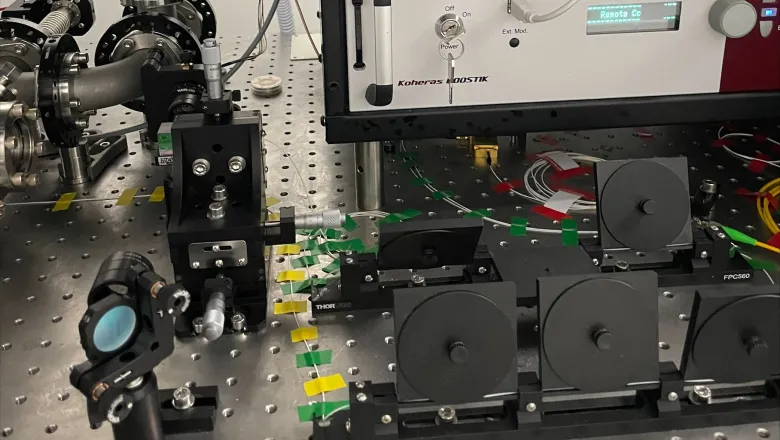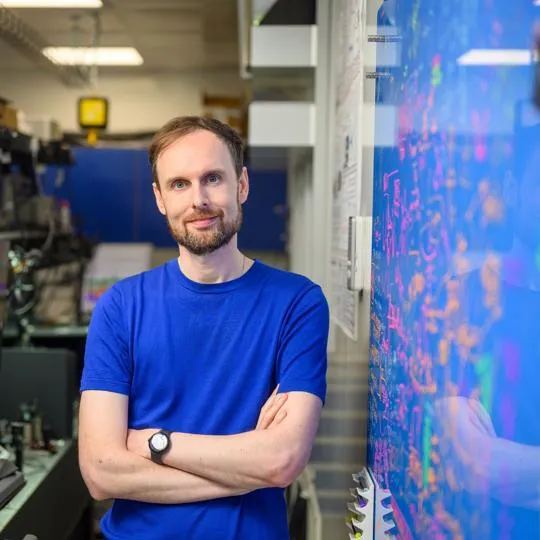Within the field of science you try to be disciplined rather than creative, but your best findings come from mistakes or failures. The abstract thinking offered by the creative environment favours the exploration of new forms of science.
Dr James Millen, Senior Lecturer in Physics & Natural Sciences
17 June 2022
Seeing the Unthinkable – King's Artists project combines quantum physics and art to explore the invisible
A collaboration between an artist and a scientist that makes information ‘hidden’ inside objects accessible to anyone.

Written by Stephanie Reed, student digital content coordinator, King’s Culture and fourth-year dentistry student in the Faculty of Dentistry, Oral & Craniofacial Sciences
All objects contain information we cannot immediately access. King’s Artist in residence Steven Claydon and Dr James Millen in the Department of Physics, Faculty of Natural, Mathematical & Engineering Sciences at King’s, explore the concept of hidden information within objects. In their project, Seeing the Unthinkable they investigate the behaviour of particles using objects of cultural significance by levitating the particles and then influencing their movement.
Steven is an artist whose work explores the cultural histories and narratives acquired by objects and artworks over time. His creative approach serves to look past the physical exterior of objects and their immediate appearance, exploring their culturally constructed meanings and properties. James’ work focuses on quantum physics and his interest in how quantum behaviours may affect culture and technology.
In Seeing the Unthinkable, Steven and James are analysing the behaviour of objects when they are levitated. From this, they obtain new information about these objects and explore ‘intelligence systems’ encoded within their motion.
More specifically, James and Steven levitate nano-particles and micro-particles (tiny particles of matter) using electrical fields to isolate them from their environment and light to see how they move. From the start they were looking for a way to disrupt the behaviour of these particles by introducing a range of information inputs. One option is music, given Steven’s experience as a musician. Other options include climate data, or information acquired by using sensors to detect the movement of the viewer. The consideration of these options takes into account how ‘the human observer’ would contribute to, and interpret, the information affecting these particles.
The project has evolved from there, with Steven and James considering the use of noise from nature to affect the particle movement. James explained how noise is interwoven with all aspects of life, right down to the molecular level of the incessant moving of cells, with proteins moving and gaining energy from thermal noise.

Steven has taken the project further by focusing on the value of the cultural objects being used. He chose 2000-year-old Ancient Chinese spade money made of metal, making it possible for an electric current to be applied through it. Steven and James are now levitating particles within this ancient ion trap, an object made of material that was once of great value but is now used in a much more functional way. They have been levitating diamond dust, intrigued by the fact that the diamond is of high value, however it is cheap in dust form.
I was very interested to know how this project differed from other science projects James would normally work on. James said that the crucial aspect setting this experiment apart is the audience; ‘this project has to be viewed’. Mostly, when working with quantum mechanics, there is equipment that views the data, however, the light used is not visible to the human eye. James and Steven’s project, therefore, makes the information accessible to anyone.
The project is still evolving, and James and Steven see the possibility of opening it up to more people by livestreaming the experiment and allowing viewers to add their own noise to influence the movement of particles.
‘Seeing the Unthinkable’ opens up quantum mechanics to a whole new audience by making quantum data accessible to non-physicists.
Dr James Millen, Senior Lecturer in Physics & Natural Sciences
It is not the first time that Steven has worked on a project that breaks the boundaries between physics and the general public. He previously presented his work at Science Gallery London, in the 2019 exhibition Dark Matter, with a piece that drew on his research into the material reality of the world at an atomic level. James has also been building his portfolio in public engagement, teaching quantum mechanics to people without any scientific background.

I was particularly interested in how James and Steven focus on different aspects of the experiment. James cares about how and why things levitate and move, while Steven ‘will be interested in one wire or the oscilloscope, or simply the platform on which everything is placed’ - aspects a physicist wouldn’t think twice about. So, while Steven would prefer to display the wires and tapes that hold an experiment in place, a physicist’s usual practice would be to tidy them away. These different approaches show how complimentary the art and science pairing can be.
‘Seeing the Unthinkable’ will be at Science Gallery London this autumn as part of a showcase of King’s Artists projects in the gallery’s reopening programme.

